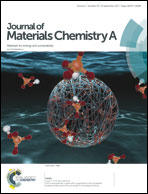Bromination-induced stability enhancement with a multivalley optical response signature in guanidinium [C(NH2)3]+-based hybrid perovskite solar cells†
Abstract
Guanidinium lead iodide (GAPbI3) has been synthesized experimentally, but stability remains an issue, which can be modulated by the insertion of bromine (Br) into the system. We have performed a systematic theoretical investigation to see how bromination can tune the stability of GAPbI3. The optical properties were also determined, and we have found formation enthalpy-based stability in the perovskite systems, which are active in the visible and IR region even after bromine insertion and additionally more active in the IR range with the transition from GAPbI3 to GAPbBr3. The spin orbit coupling effect is considered throughout the band structure calculations. The ensemble of the primary and secondary gaps in the half and fully brominated hybrid perovskites leads to the phenomenon of a multipeak response in the optical spectra, which can be subsequently attributed as multivalley optical response behaviour. This multivalley optical behaviour enables the brominated guanidinium-based hybrid perovskites to exhibit broad light harvesting abilities, and this can be perceived as an idea for natural multi-junction solar cells.
![Graphical abstract: Bromination-induced stability enhancement with a multivalley optical response signature in guanidinium [C(NH2)3]+-based hybrid perovskite solar cells](/en/Image/Get?imageInfo.ImageType=GA&imageInfo.ImageIdentifier.ManuscriptID=C7TA03114A&imageInfo.ImageIdentifier.Year=2017)


 Please wait while we load your content...
Please wait while we load your content...